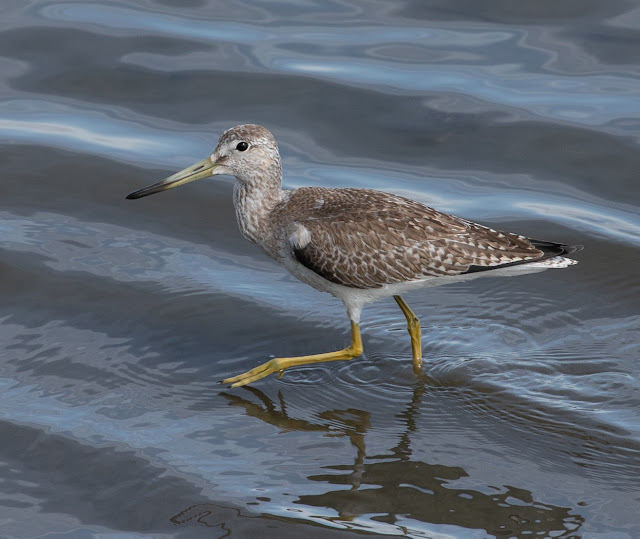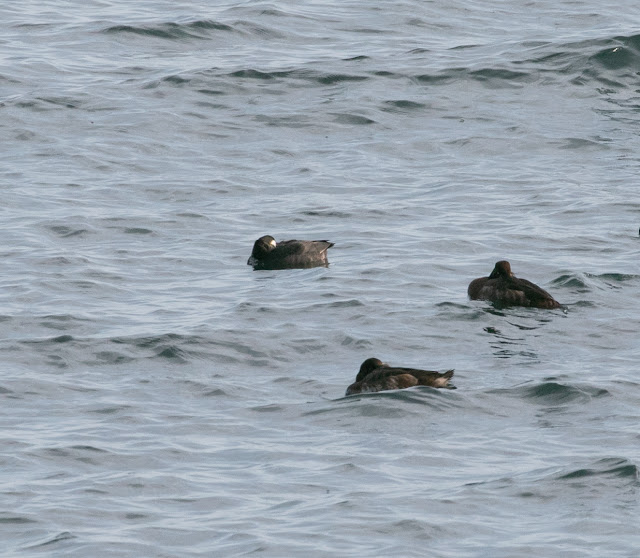Spring migrants should all have completed their journeys by now, any that haven't are potential megas waiting to be found. It's therefore time to reflect on the good birds I did see (Thick-billed Warbler), those I didn’t (Redwing and Chinese Blackbird) and what I might have... and to that end, I do have a ‘funny’ locustella
warbler that has been bothering me ever since I came across it on a day trip to Hegurajima on
9 May.
Despite
some unresolved questions about its appearance at the time, I concluded it had
to be a Middendorff’s Grasshopper Warbler before heading for the ferry. Once back
home I looked through my iffy images which only amplified my confusion.
I first saw
it in bright sunlight clinging to the outside of a clump of pampas grass in one
of the harbour-front ‘gardens’ as I was drifting towards the waiting ferry. My instinctive reaction was Oriental Reed
Warbler, not only did it seem large and long-tailed but it had the uniform light-brown
upperparts you might expect from first glance of a brightly sunlit Oriental
Reed. Before I got the bins on it, it flew into deep shade and tangled
vegetation at the foot of the steep slope next to a house. That might have been
the end of it as I wasn’t going to spend much time trying to get a better view
of an Oriental Reed when my four and a bit hours on the island was all but up. However, I caught a
glimpse of it creeping around on the ground and waited a little longer. I
managed to see bits of it as it crept under or clambered through lower stems; enough bits to realize it wasn’t an Oriental Reed.
It was 30
metres away in deep shade and frequently obscured by vegetation, I couldn’t make
out much detail but quickly checking through shots on the back of the camera I
could see white tips to the longest tail feathers and concluded it must be
a Middendorff’s, although I was a bit puzzled by my initial impression of it
being large and long-tailed.
The bird’s
appearance has niggled ever since. My thoughts then turned to the size and structure seeming better suited to
Styan’s, which I've never seen on Hegura, while the plumage leans to Middendorff’s without it being quite what
I’d expect. However, lightly streaked locustella
with white tips to the tail has to be either a Styan’s or Middendorff’s, that much is straight forward, but
which, and from which population?
I see
plenty of Middendorff’s on Hegura in autumn (even the odd ones in Kyoto city),
particularly autumn juveniles, which aren’t really relevant in terms of
plumage but it’s been many years since I’ve had good views of spring Middendorff’s, which effectively means I have zero experience. This might be partly responsible for me thinking the plumage looks a bit ‘off’. Nevertheless, plumage aside, Middendorff’s always strike
me as well proportioned, somewhat lightly-built, with a relatively fine bill and
a shortish tail, unlike this bird. I can see my ‘local’ population of Styan’s throughout summer,
from fresh arrivals in May to worn and faded birds in August. They’re a stronger-looking warbler with a deep bill and a longer, broader tail, matching
the Hegura bird to an extent, but in terms of plumage they’re peas from the
same pod (apart from the extent and saturation of greyish-brown wash on the underparts) and nothing like the Hegura bird.
It’s
tempting to leave it as Middendorff’s/Styan’s. However, the intriguing
possibility of identifying a subcerthiola
Middendorff’s or a ‘continental’ Styan’s prevents me from quite letting this
go. Kennerley (Reed and Bush
Warblers) describes subcerthiola as
larger than ochotensis and
northernmost birds as a match for Styan’s in size. Could this account for my
feeling this was a large bird? I have no idea whether subspecies are identifiable in the field so it seems a bit of a stretch.
Things which to me don’t seem to sit well with the Middendorff’s indentification:–
Structurally,
this was a large, heavily-built warbler with a very deep bill and a long, broad
tail which never suggested it could possibly be neatly rounded if spread; the tail was like
a plank!
At no time did
I see the usually fairly obvious whitish edge of P2, nor can I detect it in any
of the images I have.
Things that
don’t seem to sit well with anything:–
The tail
structure looked odd. T1–2 were broad and surprisingly squared-off, further, instead of having evenly spaced T3–6 with T6 about level with the tips of the undertail coverts,
this bird T5–6 bunched closely together and well past the undertail coverts. Additionally,
it lacked both cross barring and white tips to the underside of the tail feathers. As it
was possible to detect subtle whitish undertail covert tips on a pale ground, any tail markings should
have been fairly easy to make out even in these views, I would have thought. Only T1–2 had white tips, narrowly on the former and more
prominently on the latter.
The sides
of the throat and the upper breast were heavily streaked, the sides of the breast were grey and met in the centre as a mottled grey breast band producing a clear divide between the white throat and yellowish underparts. Prominent breast streaks and yellowish tints might be expected in juveniles but not in spring birds I wouldn't have though, certainly not to this extent. Even then, the yellowish hues of juveniles are more centred on the throat rather than the underparts.
An important point to stress is that assessing plumage details both in the field and in these images was/is tricky because the bird was constantly moving between strong sunlight and deep shade, it was often dappled and rarely in good viewing conditions. In strong sunlight the upperparts looked uniformly pale brown but in light shade the bird was a much darker brown with greyish nape and cheeks and with clear dark centres to crown and mantle feathers creating a subtly streaked appearance. There's a suggestion in one or two images that the rump/uppertail coverts might be slightly paler than the mantle but I didn't notice that in the field and am therefore unsure about this point.
One thing which may or may not be of relevance is that looking through the Macaulay Library images of
Middendorff’s dated early May, there were two images that caught my eye but neither showed the whole bird so I don't know whether they were really similar but in each the bird shown has a very streaked throat
and both these images were taken in the ROK in early May. Is this coincidental? I’d
have assumed the most northerly breeding locustella would be arriving at a later date?
How much fresher-looking are early May birds compared to a month later? More questions than answers.
First some shots of my local Styan's Grasshoppers for comparison.
 |
| It always seems sunny when I go so a shot in duller conditions is good. Strong, deep-based bill and relatively long tail are apparent. This late June bird is already looking a bit tatty about the vent/undertail coverts. |
 |
| They are very plain-looking birds (this early June) but have a strong bill and quite long tail extending well beyond the longest undertail coverts. |
 |
| The undertail cross-barring and evenly-spaced white tips should be equally obvious on Middendorff's I'd have thought. |
And a couple of mid-October Middendorff's...
 |
| To me, this would is a fairly typical Middendorff's, dainty, spiky bill and short, rounded tail. |
 |
| Despite the foreshortening at this angle, the tail gives a rounded impression, fitting well with the full undertail coverts. |
And the bird in question...
 |
| That's quite a bill its got, more in the Gray's/Sakhalin class. Bold throat streaking extends diffusely onto the flanks. |
 |
| It was only in good light (ie shade but not too deep) that head and mantle streaks became apparent. I don't think the pale tip to the bill means anything but it was always noticeable. |
 |
| This is what I mean by 'tail like a plank', long, broad and straight. There's a hint of contrasting uppertail coverts here. |
 |
| This shows the narrow white tips of T1 and broader tips of T2. |
 |
| I almost feel I'm trying to identify a SE Asian bulbul rather than a locustella. The undertail is remarkably uniform and the spacing of the feathers looks very odd; this is never going to produce a short, rounded effect if spread. Yellowish tinted underparts are strange too. |
 |
| Why is the almost hidden photo-bomber in focus?! The grey sides of the breast meet in the centre creating a clean divide between the white throat and yellowish underparts. |
Birding would be so boring if everything was easy.




























